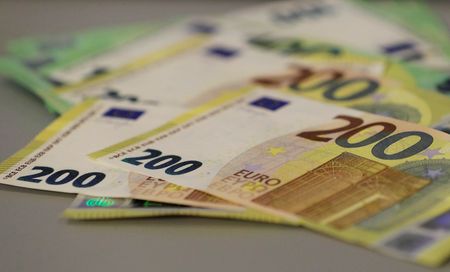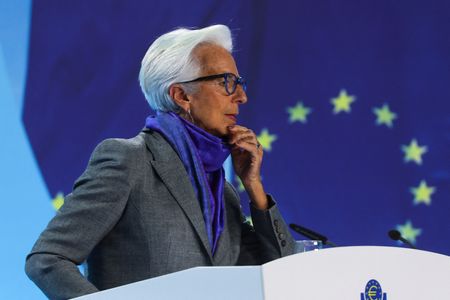By Francesco Canepa and Balazs Koranyi
FRANKFURT (Reuters) – The European Central Bank raised interest rates by 0.5% on Thursday and explicitly signalled at least one more hike of the same magnitude next month, reaffirming it would stay the course in the fight against high inflation.
But financial markets immediately interpreted the move as suggesting the tightening cycle might in fact end soon – just as they had done on Wednesday after U.S. Federal Reserve chief Jerome Powell said there were signs inflation was easing.
Speaking to Reuters after the meeting, three ECB policymakers pushed back on the market’s reaction, saying on condition of anonymity they fully expected at least another rate hike in May.
ECB President Christine Lagarde also disputed the interpretation that Thursday’s move meant the hiking cycle was nearing the end.
“No. We know that we have ground to cover, we know that we are not done,” she told a news conference, reiterating the bank’s mantra that it would “stay the course” in the fight to bring inflation back down to its target of around 2%.
The ECB has been increasing rates at a record pace to fight rising prices which are the byproduct of factors including the aftermath of the COVID-19 pandemic and an energy crisis that followed Russia’s invasion of Ukraine nearly a year ago.
On Thursday, the central bank for the 20 countries that share the euro raised the rate it pays on bank deposits by another half-percentage point to 2.5%, in line with what it had said in December and with market expectations.
It said the next rate increase would be of the same size, but left its options open further ahead. The three policymakers who spoke to Reuters said the May rate hike could be worth 25 or 50 basis points.
“The Governing Council intends to raise interest rates by another 50 basis points at its next monetary policy meeting in March and it will then evaluate the subsequent path of its monetary policy,” the ECB said.
ING’s global head of macro Carsten Brzeski said the ECB was “opening the door to either a pause or a slower rate hike pace beyond March”, a view that was reflected in market moves as Germany’s 10-year yield fell 15 bps to 2.14%.
The disconnect between the ECB message and the market interpretation mirrored that on Wednesday after the Fed slowed the pace of hikes and acknowledged disinflation was underway, while reaffirming that borrowing costs needed to rise further.
The U.S. 10-year Treasury yield was down 3 bps at 3.36%, after falling as much as 13 bps on Wednesday following the Fed meeting.
Separately, the International Monetary Fund urged central banks in a blog published on Thursday to “communicate the likely need to keep interest rates higher for longer” in order to bring inflation sustainably back down to target.
Lagarde stressed that for the euro zone, she would not say disinflation was already starting.
“We still have underlying inflation factors that are strong, solid and are not budging, so we need to do our job,” she said, adding that beyond March, the next rate hike in May could be 25 bps, 50 bps or whatever was needed.
Before the ECB decision, investors and economists were expecting the ECB to raise its deposit rate by another 50 basis points in March and take it to a peak of 3.25%/3.50% by summer, which would be the highest since the turn of the century.
Graphic: ECB hikes again and signals more to come
OUTLOOK
Lagarde acknowledged the outlook had become less worrisome for growth and inflation, saying risks for both were now “more balanced” than in December.
The euro zone unexpectedly eked out growth in the final three months of 2022 but this was largely due to an exceptionally mild winter and a stellar performance by Ireland.
“The economy has proved more resilient than expected and should recover over the coming quarters,” Lagarde added.
Headline inflation has been in rapid decline since peaking at a record 10.6% in October but core prices, which exclude volatile items such as food and fuel, have been rising at a steady or accelerating pace.
And an ECB survey showed banks were tightening access to credit by the most since the 2011 debt crisis – which Lagarde saw as a sign that the ECB’s rate rises were having the desired effect on the economy.
“The risks to the inflation outlook have also become more balanced, especially in the near term,” Lagarde said.
The ECB also gave more details of its plans to whittle down the 5 trillion euros of bonds it accumulated over the last decade as it tried to boost inflation that was then too low.
Graphic: The race to raise rates The race to raise rates- https://www.reuters.com/graphics/CANADA-CENBANK/dwvkdeaqopm/chart.png
(Editing by Catherine Evans)



